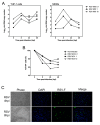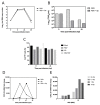RSV Infection in Human Macrophages Promotes CXCL10/IP-10 Expression during Bacterial Co-Infection
- PMID: 29215596
- PMCID: PMC5751256
- DOI: 10.3390/ijms18122654
RSV Infection in Human Macrophages Promotes CXCL10/IP-10 Expression during Bacterial Co-Infection
Abstract
Respiratory syncytial virus (RSV), a major etiologic agent of acute lower respiratory infection constitutes the most important cause of death in young children worldwide. Viral/bacterial mixed infections are related to severity of respiratory inflammatory diseases, but the underlying mechanisms remain poorly understood. We have previously investigated the intracellular mechanisms that mediate the immune response in the context of influenza virus/Streptococcus pneumoniae (Sp) co-infection using a model of human monocyte-derived macrophages (MDMs). Here, we set up and characterized a similar model of MDMs to investigate different scenarios of RSV infection and co-infection with Sp. Our results suggest that Sp contributes to a faster and possibly higher level of CXCL10/IP-10 expression induced by RSV infection in human MDMs.
Keywords: Streptococcus pneumoniae (Sp); acute lower respiratory infection; co-infection; macrophages; respiratory syncytial virus (RSV).
Conflict of interest statement
The authors declare no conflict of interest. The founding sponsors had no role in the design of the study; in the collection, analyses, or interpretation of data; in the writing of the manuscript; or in the decision to publish the results.
Figures


Similar articles
-
Coinfection with respiratory syncytial virus and rhinovirus increases IFN-λ1 and CXCL10 expression in human primary bronchial epithelial cells.New Microbiol. 2024 May;47(1):60-67. New Microbiol. 2024. PMID: 38700885
-
Vitamin D Induces Differential Effects on Inflammatory Responses During Bacterial and/or Viral Stimulation of Human Peripheral Blood Mononuclear Cells.Front Immunol. 2020 Apr 7;11:602. doi: 10.3389/fimmu.2020.00602. eCollection 2020. Front Immunol. 2020. PMID: 32318074 Free PMC article.
-
Respiratory syncytial virus infection of primary human mast cells induces the selective production of type I interferons, CXCL10, and CCL4.J Allergy Clin Immunol. 2015 Nov;136(5):1346-54.e1. doi: 10.1016/j.jaci.2015.01.042. Epub 2015 Mar 24. J Allergy Clin Immunol. 2015. PMID: 25819983
-
Respiratory syncytial virus and other respiratory viruses.Pediatr Infect Dis J. 2003 Feb;22(2 Suppl):S6-10; discussion S10-2. doi: 10.1097/01.inf.0000053880.92496.db. Pediatr Infect Dis J. 2003. PMID: 12671447 Review.
-
γδ T cells and the immune response to respiratory syncytial virus infection.Vet Immunol Immunopathol. 2016 Nov 15;181:24-29. doi: 10.1016/j.vetimm.2016.02.012. Epub 2016 Feb 21. Vet Immunol Immunopathol. 2016. PMID: 26923879 Review.
Cited by
-
Co-infection: when whole can be greater than the sum: The complex reaction to co-infection of different pathogens can generate variable symptoms.EMBO Rep. 2018 Aug;19(8):e46601. doi: 10.15252/embr.201846601. Epub 2018 Jul 6. EMBO Rep. 2018. PMID: 29980591 Free PMC article.
-
Viral and Bacterial Co-Infections in the Lungs: Dangerous Liaisons.Viruses. 2021 Aug 30;13(9):1725. doi: 10.3390/v13091725. Viruses. 2021. PMID: 34578306 Free PMC article. Review.
-
Understanding the interaction of upper respiratory tract infection with respiratory syncytial virus and Streptococcus pneumoniae using a human challenge model: a multicenter, randomized controlled study protocol.PLoS One. 2025 Jul 1;20(7):e0325149. doi: 10.1371/journal.pone.0325149. eCollection 2025. PLoS One. 2025. PMID: 40591700 Free PMC article.
-
Time-Dependent Increase in Susceptibility and Severity of Secondary Bacterial Infections During SARS-CoV-2.Front Immunol. 2022 May 12;13:894534. doi: 10.3389/fimmu.2022.894534. eCollection 2022. Front Immunol. 2022. PMID: 35634338 Free PMC article.
-
Time-Dependent Increase in Susceptibility and Severity of Secondary Bacterial Infection during SARS-CoV-2 Infection.bioRxiv [Preprint]. 2022 Mar 1:2022.02.28.482305. doi: 10.1101/2022.02.28.482305. bioRxiv. 2022. Update in: Front Immunol. 2022 May 12;13:894534. doi: 10.3389/fimmu.2022.894534. PMID: 35262077 Free PMC article. Updated. Preprint.
References
MeSH terms
Substances
LinkOut - more resources
Full Text Sources
Other Literature Sources
Medical

